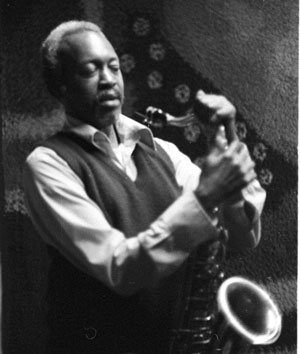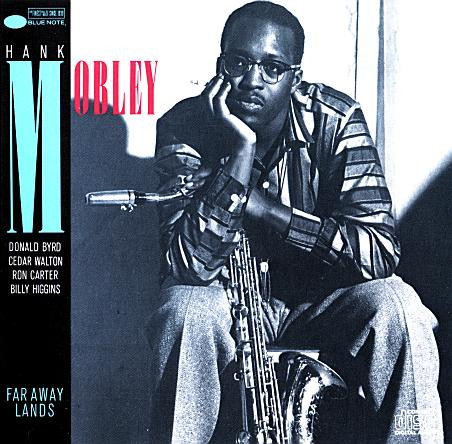Dab Of This And That – Hank Mobley
Simple and catchy but with some hip rhythms, this is another Hank Mobley song that's guaranteed to feel good. There's a vamp intro also used as an interlude to set up the first solo.
- Recording: Hank Mobley - Far Away Lands
- Recorded on: May 26, 1967
- Label: Blue Note (BST 84425)
- Concert Key: B-flat
- Vocal Range: , to
- Style: Swing (medium)
- Trumpet - Donald Byrd
- Tenor Sax - Hank Mobley
- Piano - Cedar Walton
- Bass - Ron Carter
- Drums - Billy Higgins
Video
- Description
- Historical Notes
- Solos
- Piano Corner
- Bass Corner
- Drum Corner
- Guitar Corner
- Inside & Beyond
- Minus You
A bouncy medium swinger with that classic Hank Mobley sound. It's 16 measures long, with a blues-like form but going back to the IV chord in the ninth measure instead of directly to the V. The melody repeats a relatively simple riff but with a hip rhythmic snap. Our lead sheets show detailed articulations including "scoops" and "fall-offs."
There's a rhythm section vamp intro, shown in our rhythm section part; it's also used as an interlude before the first soloist. After the last solo, the intro returns to set up the out head. On the recording the rhythm section vamps and fades on the intro as an ending; our lead sheets show a shorter coda (see Don Sickler's note below). Also included in our lead sheets but not on the recording are optional two-horn harmonies— the top two notes of the piano voicings— for the second half of the interlude and coda.
Don Sickler: "I have had the honor of getting to perform A Dab Of This And That with all three of Hank's original rhythm section members over the years: with Cedar Walton and Ron Carter together on a couple of my Hank Mobley Festivals at the Jazz Standard in NYC, and a couple of times with Billy Higgins in a sextet format on my week with him for the 60th anniversary of Blue Note Records.
For all of these performances, I wanted to have a definite ending (the record fades out on a rhythm section vamp) so for quintet performances for the Mobley Festival, I added the horns in harmony for the coda and created an ending chord.
I also expanded Hank's interlude. Instead of using it just once at the end of the melody as the set up for Hank's solo on the recording, I would often like to use it as an interlude to set up the next soloist, also adding the horns in the last four measures. That's why I added the [1] so it was easy for me to cue. With our editions, you can either perform it my way, or you can do it the way Hank recorded it, simply using his eight-measure rhythm section intro as the interlude into the first soloist, and again after the last soloist (the D.C.), play the melody, and the rhythm section vamps and fades out on it. For our editions, I've also kept the melody as Hank recorded it, a 16-measure, once only melody. It's such a catchy melody, I'd sometimes also repeat it in performances before solos. Have fun experimenting with it yourself."
There's a rhythm section vamp intro, shown in our rhythm section part; it's also used as an interlude before the first soloist. After the last solo, the intro returns to set up the out head. On the recording the rhythm section vamps and fades on the intro as an ending; our lead sheets show a shorter coda (see Don Sickler's note below). Also included in our lead sheets but not on the recording are optional two-horn harmonies— the top two notes of the piano voicings— for the second half of the interlude and coda.
Don Sickler: "I have had the honor of getting to perform A Dab Of This And That with all three of Hank's original rhythm section members over the years: with Cedar Walton and Ron Carter together on a couple of my Hank Mobley Festivals at the Jazz Standard in NYC, and a couple of times with Billy Higgins in a sextet format on my week with him for the 60th anniversary of Blue Note Records.
For all of these performances, I wanted to have a definite ending (the record fades out on a rhythm section vamp) so for quintet performances for the Mobley Festival, I added the horns in harmony for the coda and created an ending chord.
I also expanded Hank's interlude. Instead of using it just once at the end of the melody as the set up for Hank's solo on the recording, I would often like to use it as an interlude to set up the next soloist, also adding the horns in the last four measures. That's why I added the [1] so it was easy for me to cue. With our editions, you can either perform it my way, or you can do it the way Hank recorded it, simply using his eight-measure rhythm section intro as the interlude into the first soloist, and again after the last soloist (the D.C.), play the melody, and the rhythm section vamps and fades out on it. For our editions, I've also kept the melody as Hank recorded it, a 16-measure, once only melody. It's such a catchy melody, I'd sometimes also repeat it in performances before solos. Have fun experimenting with it yourself."
For another Hank Mobley song with a similar riff melody (though with a different rhythmic feel), check out Give Me That Feelin', recorded three months earlier on the "Third Season" album.
"Far Away Lands" was Hank Mobley's only recording with Ron Carter. This rhythm section with Carter, Cedar Walton and Billy Higgins first recorded together in 1965 on Eddie Harris' classic "The In Sound;" in the '90s they reunited as the Sweet Basil Trio. Another album with the same rhythm section is Don Sickler's "The Music Of Kenny Dorham."
"Far Away Lands" was Hank Mobley's only recording with Ron Carter. This rhythm section with Carter, Cedar Walton and Billy Higgins first recorded together in 1965 on Eddie Harris' classic "The In Sound;" in the '90s they reunited as the Sweet Basil Trio. Another album with the same rhythm section is Don Sickler's "The Music Of Kenny Dorham."
Related Songs
Email Send Dab Of This And That to a friend
Send this page to a friend via email. Add your name or email in the first field. In the second, add one or more email addresses, separated by a comma.

Hank Mobley
July 7, 1930 – May 30, 1986
Hank Mobley is one of the most acclaimed tenor saxophonists in modern jazz history. He is recognized by musicians and critics alike as one of the most important and eloquent jazz instrumentalists of all time. He recorded well over 100 of his own original compositions and left an indelible mark on the post-bop jazz scene. Read more...
There was a problem.
...

